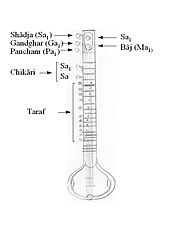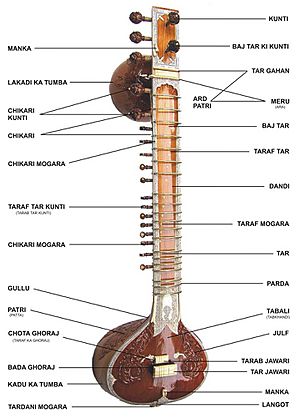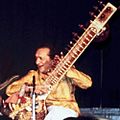Sitar facts for kids
 |
|
| String instrument | |
|---|---|
| Classification |
|
| Related instruments | |
The sitar ([] Error: {{Lang-xx}}: no text (help)/Sanskrit: सितार, Urdu: ستار) is a special musical instrument with strings that you pluck. It has a long, hollow neck and a round, hollow part called a gourd at its base. This design helps it make a rich, full sound. The sitar is famous for its unique sound, which comes from extra strings that vibrate on their own. People play the sitar all over India.
Contents
What Does a Sitar Look Like?
A sitar can have many strings, usually between 18 and 21. Some of these strings are played directly, and they run over curved, raised bars called frets. The other strings are called sympathetic strings. These strings are underneath the frets and are not plucked directly. Instead, they vibrate and make sound when the main strings are played. This adds to the sitar's special sound.
The frets on a sitar can be moved. This allows musicians to fine-tune the instrument and play different notes. The strings you play go to tuning pegs near the top of the sitar. The sympathetic strings, which are different lengths, go through small holes in the fretboard to smaller tuning pegs along the neck.
How Many Strings Does a Sitar Have?
There are different kinds of sitars. One type, called the Gandhaar-pancham sitar, has six strings that you play. Another type, the Kharaj-pancham sitar, has seven playable strings. This type was used by famous musicians like Ravi Shankar.
On most sitars, three or four of the playable strings are called chikaari strings. These strings are used to make a steady background sound, like a drone. The other strings are used to play the main tune, or melody. The first string, called the baajtaar, is used the most for playing melodies.
What Makes the Sitar's Sound Special?
The sitar has two bridges. A large bridge holds the main playing strings and drone strings. A smaller bridge holds the sympathetic strings. The unique sound of the sitar comes from how the strings touch the wide, sloped bridges. As a string vibrates, it slightly changes length where it touches the bridge. This creates many extra sounds called overtones, which give the sitar its special tone.
Keeping this specific tone by shaping the bridge is called jawari. Many sitar players rely on skilled instrument makers to adjust this part perfectly.
What is a Sitar Made Of?
The bridges are attached to the main sound box, which is called the kaddu. This is usually made from a calabash gourd, which is a type of squash. Some sitars also have a second sound box, called a tumbaa, near the top of the hollow neck.
The neck and the front part (tabli) of the sitar are often made from teak wood or tun wood. Tun wood is similar to mahogany. The bridges are traditionally made from deer horn, ebony wood, or sometimes camel bone. Today, people also use synthetic materials for the bridges.
Images for kids
-
A black ebony wood Jawari
-
Ravi Shankar in 1988
See also
 In Spanish: Sitar para niños
In Spanish: Sitar para niños






